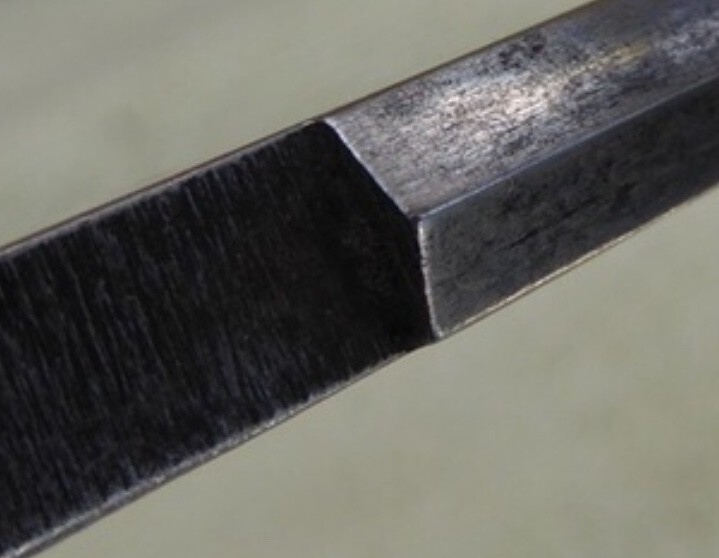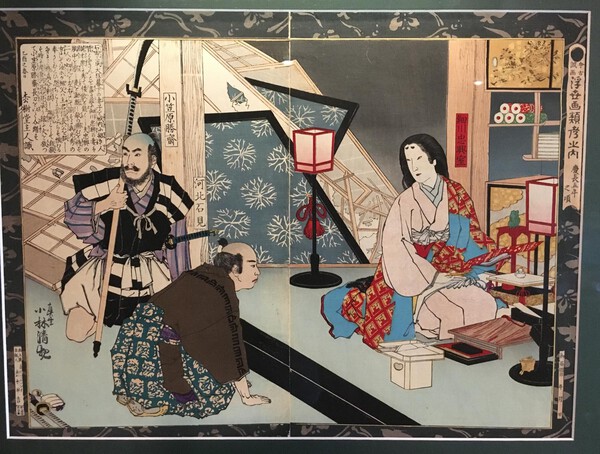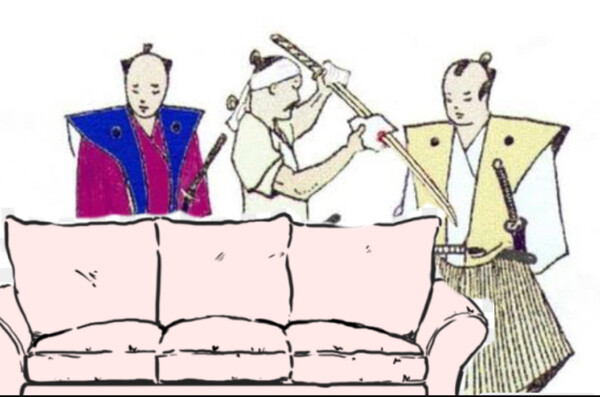
RichardP
-
Posts
202 -
Joined
-
Last visited
-
Days Won
1
Content Type
Profiles
Forums
Events
Store
Downloads
Gallery
Posts posted by RichardP
-
-
Whoa—thanks all, I’ll post more pics when it arrives...
-
 1
1
-
-
Sorry for the strained necks, guys, images corrected...
-
-
-
Very handsome! What’s the motif on the kozuka? (Looks like bag of money and false beard?)
-
I see that blade features the optional bottle opener...
-
 1
1
-
 2
2
-
-
“Today, across this country, our youngest and most vulnerable shoulder the burden of paperless, mumei shinto waks. Here, at Katanas for Kids, we believe that all children...” <cue Sarah McLachlan>
-
 5
5
-
-
Is the mune’s geometry off, or am I seeing things?

-
I’ve never seen a tsuba that immediately made me start humming the theme to “Super Mario Bros”... Impressive!
-
 2
2
-
-
Does the extent of the yasurime—over what seems to be the entirety of the nakago—lend any weight to the theory that this is ubu? (That is to say, as a sword is shortened, is it common for “new” yasurime to be added as the nakago moves up the sword?)
-
 1
1
-
-
Ford Hallam discussed this bad binocular mamma-jamma on his channel. Behold, the Leica A60:
https://www.leica-microsystems.com/products/stereo-microscopes-macroscopes/p/leica-a60-f/
-
https://m.youtube.com/watch?v=kPsFoudYVSgWhat was the Japanese cultural view on lefties?
(A clip from one of my favorite guilty pleasures, the 1995 film The Hunted.)
-
 1
1
-
-
Would be slick if the case had a knurled dial on its face that could be turned, gradually changing the angle of the mounts / position of the lights...
-
Hey Paul! Knowledgeable folks should be along to help you out shortly—they’ll probably be better able to help you if you provide a little more pics/information. A picture of the blade from above, against a plain background, would help to determine if your sword has the shape/silhouette consistent with Hizen workmanship. (The signature seems to be Hizen Kuni Ju Tada Somethin’.) What’re the blade dimensions? Your sword is signed on the side one would expect for Hizen wakizashi, so if this is instead katana-length, it probably raises some questions about the legitimacy of the mei. The chisel-marks in the mei look pretty rough to my eyes and the patina seems odd, but I’m a rank newbie so don’t worry just yet! I hope the experts can give you some good news. Closer pics of the steel may get you more confident responses, and the forum requires all posts to be signed. Good luck!
-
 1
1
-
-
Another Kobayashi Kiyochika—
My understanding is that this portrays the last moments of Hosokawa Gracia, after it has become clear that all was lost and she would soon be in the clutches of Ishida Mitsunari (her husband, Hosokawa Tadaoki, was off on campaign with Tokugawa Ieyasu).
I believe the official version of her death is that her newly-adopted Catholicism—with its prohibition on suicide—prevented her from taking her own life, so she asked her retainers to be the ones to kill her, then to burn the place down and kill themselves. (Apparently a Jesuit witness left a more cynical account, stating that it was her husband, on his way out the door to join the fighting, who took the retainers aside and instructed them that if all appeared lost, they were to kill his wife, kill themselves, and burn the place down.)
I really like this very different version that is (I think!) being portrayed by Kiyochika:
The lady sits with a sash tied about her knees to maintain decorum in her death throes, having just finished her death poem. A dagger lies on a table next to her. Her retainers stand guard in the foreground, but it is the lady herself who will be taking her own life, by her own hand.
Not sure if this is what Kiyochika is actually communicating—seems kind of subversive, right? Been meaning to retain Mr. Sesko’s services and have translations done...
(This is mounted, but I had them use museum glass and acid-free paper, and it doesn’t see sunlight.)
-
 5
5
-
-
Ok, don't groan too loudly, but for a guy completely ignorant about polishing, can someone possibly explain for me why the hamon pattern on this is a result of it? I'm like Mike at the start - it looks like a suguha overlaid by a wavy hamon. Seems like 2 patterns.
Me three! Hoping I’m not muddying the waters, but there’s this, from Mr. Hofhine’s site:
“If the blade has a hamon such as sanbon-sugi or some togari-ba, a sashikomi finish may also be preferable. This is because the hamon consisting of many narrow, high, widely separated peaks, may not fit well into a keisho wave form...”
(http://ipolishswords.com/Keisho.html)
Regarding this polish, would it be fair to criticize the suguha element as overexposed? (The suguha seems to cut through the peaks and overpower them, resulting in what seems like two overlapping hamons, rather than a single harmonious one—or am I well off base?)
Here’s Mr. Brockbank on sanbonsugi:
-
 1
1
-
-
This thread is pretty amazing...
-
-
The squiggle-like carvings you mention are Sanskrit, I believe. It’s my understanding that horimono were sometimes used to conceal flaws—something to consider, especially if the horimono seems oddly placed. Despite how gorgeous and intricate some of the workmanship is, I have a hard time not thinking of the phrase “gilding the lily” (just my uncultured opinion).
-
-
Aw man, that would make for a great saidan-mei: “On Tenpo 14, cut through two sofas and a barcalounger.”
-
 4
4
-
-
Isn’t there a blade with a seven-body cutting attestation that’s taken (at least semi) seriously?
-
“...and I believe that the kissaki of the blade is pinched in some way so as to keep the rest of the whole blade suspended in a neutral space”
That’s something I’ve often wondered—what is it that keeps the tip from pendulum-ing laterally?
-








Found a tsuba...
in Tosogu
Posted
0.40” at rim
159 gr.
I’m just... awestruck.
This beauty’s going to shinsa for sure!
(I think it was the whisker-holes on the dragons’ muzzles—and the way the nanako bends around the mimi—that finally broke my brain...) While this may be gimei, I keep thinking of Darcy’s article on Ichijo’s unreal ability to work in hyper-miniature.
There a few tiny areas of blunt-force damage to the nanako, but the condition otherwise seems fantastic. There is heavy grime visible within the centers of the coiled dragons that I’m not about to mess with.
Would love to have you all’s input, and particularly Mr. Ford’s: Is there any reason NOT to immediately pursue shinsa? I was thinking that the expense of any restoration work should be delayed until I get positive shinsa results—or would my odds at shinsa be improved by having it restored first?
Thanks guys, off to go breathe into a paper bag...